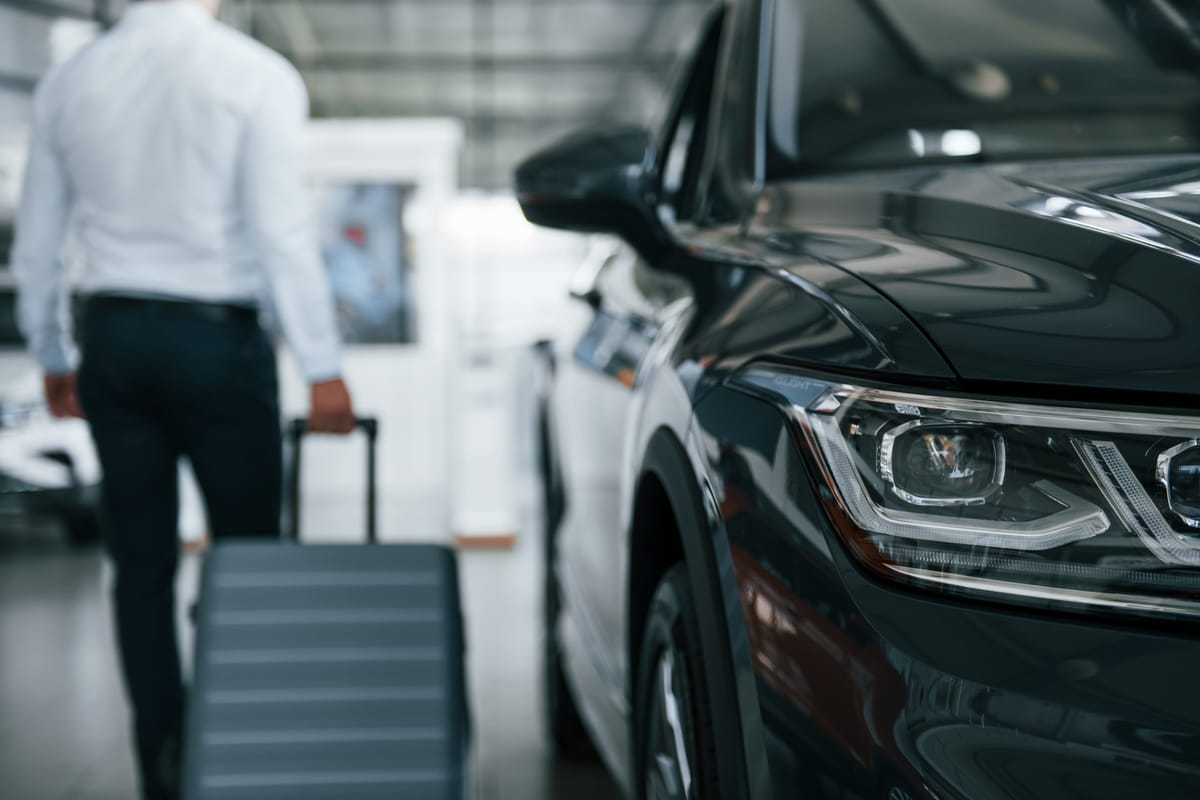The Ultimate Guide to Selling Your Car When Relocating from Kenya

Relocating is chaotic. Between packing, visa paperwork, and emotional goodbyes, selling your car often becomes an afterthought—until it’s almost too late.
Whether you want to free up some funds for your travel or are simply looking to lighten your load, selling your car when relocating makes sense. However, Kenya's car market has its own dynamics.
From preparing your car to attract buyers, to advertising effectively and negotiating like a pro, being strategic will make the process smooth and rewarding. That’s why Peach Cars has prepared this guide to help you privately sell your car efficiently and at a fair price. It also offers a simpler solution that’ll let you focus on the adventure ahead.
Why Selling Your Car Before Relocating Makes Sense
Selling your car before relocating can save you time, money, and the logistical hassles involved in the process of moving. Here are some compelling reasons why some car owners do it:
- Exporting a car can be costly, considering shipping fees, import duties, and compliance with regulations in the destination country. These costs can quickly add up and might not be justified by the car's value.
- You’re likely more familiar with Kenya’s car market than the market in your new location. This familiarity can help you sell your car faster and more effectively and avoid potential downsides.
- Selling your car locally can provide some extra cash for relocation expenses such as moving services, travel, and setting up a new home.
- Managing a car sale from abroad can be stressful and complicated. Selling before you leave simplifies your relocation process.
1. Deciding How to Sell Your Car – Weighing Your Options
You've got options, but which one is the winner for you? It boils down to how much effort you're willing to put in versus how quickly you need the cash and the price you're aiming for.
Option 1: Private Sale
Selling privately will no doubt get you the price you want, but it takes time. This method gives you control to set prices and deal directly with buyers 1. Think of it as maximizing your ROI. You call the shots, from the first ad to the final handshake 1. Plus, talking directly to people can sometimes lead to a better connection and a smoother deal 2.
But let's be real, this takes time. You're handling everything from the ads, the endless negotiations, the showings, the test drives, and all that mandatory paperwork.
Negotiations can drag on, and enough caution should be taken to minimise the risk of getting scammed or getting lowballed and selling your car at half the price. The bottom line here is that selling privately might have the potential for bigger profits, but taking control of the situation from the beginning to the end is very important.
Option 2: Selling Through a Car Dealer
Selling through a reputable car dealer can be another hassle-free option, especially if you're short on time. Dealers handle the paperwork, advertising, and negotiations, making the process faster and smoother. You have two main ways to do this:
- Direct Sale to a Dealer – The dealer buys your car outright, giving you a quick and guaranteed sale. It’s the fastest way to sell, but may fetch a slightly lower price.
- Consignment Sale – The dealer lists your car and sells it on your behalf. You get a better price, but the process may take longer. Some dealers charge a commission or fee for this service.
Both options save you time, but the choice depends on how fast you need the money versus how much you want to get for your car.
2. Get Your Car Ready for the Sale
Once you've decided on your preferred method of selling, the next step is to get your car ready for sale. A well-prepped car sells faster and for more money.
To get started:
Gather the Essential Paperwork
First things first: the original logbook. This is non-negotiable. It proves you own the car and is essential for the transfer. Without a logbook, you won’t sell your vehicle.
Next up is the service history record to show buyers you've taken care of your car. Make sure that you have a recent one.
Apart from the service record, don't forget your ID (national ID or passport) and KRA PIN certificate. You'll need these for the online ownership transfer through the National Transport and Safety Authority (NTSA).
It's also a good idea to collect any other relevant paperwork you might have, such as the original purchase invoice, any receipts for significant repairs, or even the car's owner's manual. Having these documents organised and easily available will not only streamline the selling process but also reassure potential buyers about the car's legitimacy and history.
Make Your Car Look Appealing
First impressions matter. Clean your car thoroughly, inside and out. Wash and detail the interior, then vacuum and deodorise it. A clean car shows it’s always been taken good care of, which can add to its perceived value.
Also, fix those minor repairs – small scratches, worn wipers, faulty lights. These little things can make a big difference. Check all fluids (oil, coolant, brake fluid) and make sure your tyres are properly inflated.
Then before showing your car to the prospective buyer, ensure that you’ve removed all personal belongings from the interior, including the boot, the glove compartment and storage pockets.
Get a Recent Inspection Report
While personal vehicles in Kenya don’t require an inspection report for sale, obtaining one can significantly enhance the selling process. At Peach Cars, we recommend sellers consider a pre-sale inspection by a trusted mechanic. This inspection serves two primary purposes: it helps sellers accurately price their vehicles and provides potential buyers with confidence in the car's condition.
With this report, you can effectively address any hidden issues beforehand, ensuring transparency and building trust with buyers. This way, you will facilitate a smoother transaction and reassure a buyer that they are purchasing a vehicle that meets their expectations.
3. Determine the Value of Your Car
Price your car reasonably. Too high, and you'll scare people away. Too low, and you're leaving money on the table. To do it right, search for a similar car in the market and check how much it costs.
Check local listings or use car valuation tools such as Peach Insight. These will give you an estimated market value. But remember, accuracy can vary.
Keep in mind that it's not just about age:
- Mileage, upgrades, the car’s condition, and special features (like leather seats or AC) all play a big role in determining your car’s value.
- The demand for your specific make and model in Kenya matters too. Popular, reliable brands tend to hold their value better. For example, CFAO (Toyota) holds a 59% market share in Kenya. A Toyota Premio will, therefore, sell 2x faster than a Peugeot 308.
The point is that understanding all the factors that affect your car’s value is important. And when it comes to the actual pricing, your asking price should be just about 5–10% higher than the market average. Kenyan buyers love to negotiate, and this buffer will protect what you’re aiming to make.
Pro Tip: Depreciation is a reality. Be realistic about your car's decreasing value over time.
4. Create a Listing That Gets Noticed (and Calls)
Your listing is your sales pitch. Make it compelling and honest to attract the right buyers. By selling through a dealership, you bypass most of the hard work involved in creating a pitch.
To sell it privately, you can list your vehicle on online marketplaces. Social media is also a good place to sell. And tell your personal network including friends, family, and colleagues. They might know someone looking.
Use Words That Sell
While writing the description, use words that sell. Be specific! Include the exact make, model, and year, the registration number, and the accurate mileage. State the colour clearly and a key selling point.
Here’s an example:
Headline Template: “[Reg. No.] • “[Year] [Make] [Model] • [Colour] • [Mileage] • [Key Selling Point]”Example: “KDR 2021 Toyota Harrier • White • 25,469 km • Fuel Saver (14 km/l) • Full-Service History”
In the body of the text, mention the transmission type (automatic or manual) and engine size. Highlight key features like AC, power windows, sunroof, leather seats, alloy wheels, and any modifications.
If you have a service history, mention it, along with the number of previous owners. Clearly state your asking price and briefly explain why you're selling (e.g., relocating).
Write clearly and simply, avoiding unnecessary words. Be honest about the car's condition, highlighting the good and disclosing any issues.
The Bottom Line: A detailed and honest description builds trust and attracts serious buyers.
Take High-Quality Pictures
Visuals are important when selling anything online. To do this right:
- Take high-quality photos in good, natural light, ideally during the day, but avoid harsh direct sunlight. Make sure your photos are sharp and in focus.
- Take photos of the entire car from all angles – front, back, sides, and those appealing three-quarter views. Don't forget the interior – dashboard, seats, steering wheel, key features.
- Get close-ups of important details like alloy wheels and tyre condition. Be transparent and include photos of any minor imperfections (if any).
- Choose a clean, uncluttered background. Consider adding watermarks to your photos.
It’s these high-quality photos that’ll make a great first impression online.
5. Showing Your Car Safely
You've got inquiries? Great! But safety first (especially when selling privately).
Filter the Noise: Screening Potential Buyers
Be ready for all sorts of inquiries. While many will be genuine, you might encounter scammers, timewasters, and brokers. Never show desperation to sell quickly – it encourages opportunists.
Take your time responding and don't feel rushed. Ask qualifying questions to gauge their seriousness – full name, location, what interests them, and how they plan to pay. Be wary of offers made without seeing the car or offers that are too good to be true – these may often lead to scams.
Screen inquiries carefully to focus on genuine buyers and avoid scams.
Arranging Viewings Safely
Your safety is important. It’s unwise to invite strangers to your home. So, suggest a neutral public place with security – petrol stations or shopping mall parking lots. Avoid isolated or unfamiliar areas.
Always tell a friend or family member about your meeting – location, time, buyer's contact info. Ask them to check in with you. If possible, bring someone with you.
And don't bring the original logbook to the first meeting – a photocopy is enough.
Test Drive
Test drives are normal, but control the situation. Ask for the buyer's driving license before they get behind the wheel and make sure that you accompany them. Never let them drive alone. While at it:
- Agree on a specific route and distance beforehand.
- Stick to public roads you know and avoid isolated areas.
- Consider having a trusted friend or your mechanic join the test drive.
All in all, these precautions will help you manage the test drives carefully to protect yourself and your car.
6. Negotiate and Get the Price You Want
Negotiation is part of the game. Approach it strategically to get a win-win deal. Remember, buyers expect to negotiate. So, build some room for a bargain. Know your absolute minimum and be ready to walk away if offers are too low. Do not settle for the bare minimum.
While negotiating,
- Don't seem too eager to sell.
- Consider letting the buyer make the first offer to gauge their expectations.
- Be honest and transparent about the car's condition.
- Stay calm and composed, don't get emotional.
- Highlight your car's strengths – service history, upgrades, special features.
If a buyer points out the flaws, justify your price based on your market research and the car's overall condition.
7. Closing the Deal
Almost there! Let's finalize the sale and make it official.
Accepting Payments Safely
Prioritize secure payment methods like bank transfers. Avoid large amounts of cash, which can be risky.
If they offer a cheque, wait until it fully clears before handing over the car or starting the ownership transfer. Cheques can bounce. Bank transfers are generally the safest option for larger amounts 7.
Never go with the buyer to their bank to withdraw funds – this could be a scam.
Get a Written Sales Agreement
Get a written car sales agreement in place. This protects both you and the buyer. Include full names and contact details of both parties, a detailed description of the car (make, model, year, registration, VIN), the agreed-upon price, payment method, and sale date.
Specify when the logbook transfer will start. Both you and the buyer should sign the agreement, and it's best to have it witnessed by a neutral third party, like a lawyer. Having a lawyer review it beforehand is a good idea.
Transfer of Ownership
The transfer of ownership is done online through the NTSA portal (via your eCitizen account).
As the seller, you initiate the transfer online. This involves uploading a scanned colour copy of the original logbook (PDF) and entering the buyer's details, including their KRA PIN.
You'll then pay the transfer fee online (mobile money or bank transfer). The fee depends on your car's engine size.
The buyer gets a notification to accept the transfer on their eCitizen account. They must log in and accept.
The process takes about three working days. The buyer will be notified when their new logbook is ready for collection at an NTSA office. Here’s a video showing the step-by-step process on how to do the transfer.
Confirmation of the Sale
Prepare a written receipt for both you and the buyer. Include the sale date, names of buyer and seller, a description of the car (make, model, registration), the final sale price, and the payment method. Both of you should sign and date it.
This receipt provides a clear record of the transaction for both parties.
Once you’re done, give the buyer all the car-related documents – the original logbook (once transferred), service history, and maybe copies of the sales agreement and receipt.
Finally, hand over the keys. Make sure they know how to collect their new logbook from NTSA.
8. Before You Go, Tie Up the Loose Ends
Reach out to your insurance company and inform them that you've sold the car. Give them the buyer's details and the sale date. The buyer needs to get their own insurance.
Cancelling your insurance is a good way to avoid future liability and potentially get a refund.
Sounds Like a Lengthy and Tiresome Process? Sell with Peach Cars!
Now, selling a car while relocating from Kenya can be overwhelming. From gathering documents and pricing your car to screening buyers and transferring ownership, the process can be time-consuming and stressful, especially if you’re pressed for time. But it doesn't have to be. You could easily sell your car through Peach Cars!
Whether you’re short on time or simply want to avoid the seemingly unending processes of traditional selling methods, Peach Cars offers a hassle-free solution, making the process quick, secure, and stress-free.
Here’s how Peach Cars makes the selling process easy:
- Your car is professionally inspected and valued so that you get a fair price without the guesswork.
- You get secure transactions with escrow services and verified buyers. You never have to worry about fraud or delayed payments (and if you’re in a hurry, your money can be wired to you wherever you are).
- You enjoy end-to-end support. From drafting sale agreements to handling NTSA logbook transfers, the Peach team takes care of all the paperwork so you can focus on your relocation.
- With access to a pool of high-intent buyers actively seeking used cars, Peach Cars increases your chances of selling quickly and at a competitive price.
Let Peach Cars handle the complexities while you focus on your new adventure. Call us today and learn how to easily get started.




